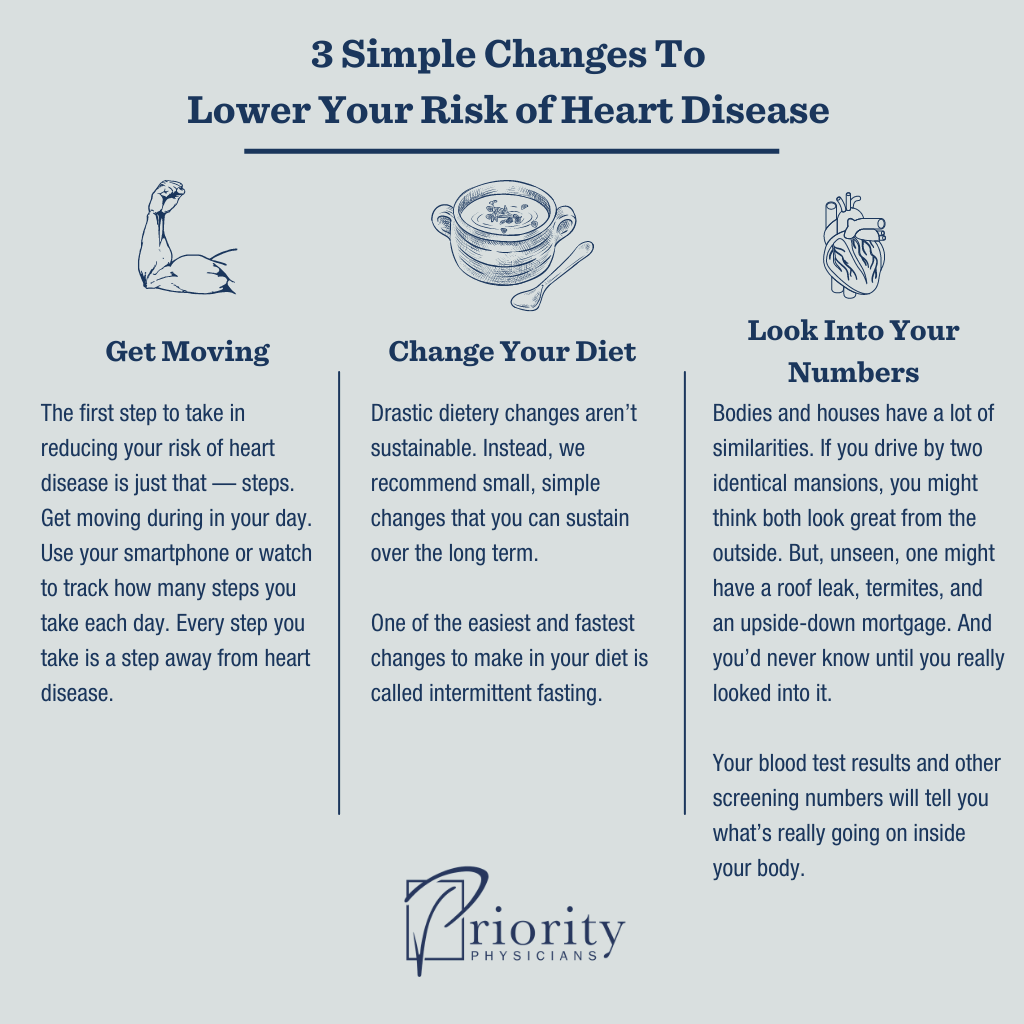One of the most common conditions we see and treat as physicians is heart disease. And there’s a reason for that.
Heart disease is the leading cause of death in the U.S. More than cancer. More than respiratory disease. More than infectious diseases.
Nearly half of all adult Americans have some form of cardiovascular disease. Every 36 seconds, someone dies from it.
Why Is Heart Disease So Common?
To understand why heart disease is so common, we need to understand what causes heart disease and why so many of us don’t know we have it.
First, heart disease builds up slowly over time. It may involve an accumulation of symptoms so subtle you just don’t notice, or it may produce no symptoms at all. In 50% of cardiac deaths, the first warning sign that a person has heart disease is a fatal heart attack. And by then, it’s far too late.
Another reason heart disease is so common and overlooked is because it’s heavily influenced by lifestyle factors such as smoking, obesity, physical inactivity, and poor diet. It’s no secret that Americans aren’t getting enough daily exercise, and most of us aren’t eating enough fruits and vegetables. And because many of these factors are highly personal, people can feel defensive or uncomfortable opening up to their doctor about them.
The good news is, there’s hope. You don’t have to become a statistic. With some simple lifestyle changes and specific screening tools, you can actively impact your resistance to heart disease.
3 Simple Changes To Lower Your Risk of Heart Disease
Now that you know how prevalent and how fatal heart disease is, you can make the conscious decision to fight it. Below are three simple changes you can make starting today that will lower your risk of heart disease.

1. Get Moving
The first step to take in reducing your risk of heart disease is just that — steps. Get moving during in your day. Use your smartphone or watch to track how many steps you take each day. Every step you take is a step away from heart disease.
We’ve probably all heard the standard, “Get 10,000 steps a day!” However, one study on the importance of getting your steps in showed that walking at least 7,000 steps per day reduces mortality risk by 50–70%, regardless of how vigorous those steps are.
If you don’t walk much now, you don’t have to go from zero to 60 right away. Just begin by finding your average steps per day now, and adding a few more — maybe 100 or 200 — gradually over time until you reach your goal.
It can help to make things fun. Find a walking partner, make a playlist of your favorite music, schedule a walking break during the day, or simply park farther away from the door when you’re running errands or at work.
If walking isn’t your thing, look for other ways to get moving: ride a bike, take a dance class, do aerobics. The most important thing is to move.
2. Change Your Diet
Another step you can take is to change your diet. What we don’t mean here is that you should go on a dramatic, pantry-cleansing diet and never eat out again. Such drastic changes aren’t sustainable. Instead, we recommend small, simple changes that you can sustain over the long term.
One of the easiest and fastest changes to make in your diet is called intermittent fasting.
Intermittent fasting is less about changing what you eat than when you eat. It involves cycling between periods of fasting (not eating) for 16 hours and periods of feasting (eating) during the remaining eight hours.
Think of it as less of a diet and more of an eating pattern.
While you’re fasting, your body burns stored fat. This leads to a healthy rate of weight loss, about 1–2 pounds per week. Studies have shown that intermittent fasting can reduce the risk of heart disease by lowering blood pressure, LDL cholesterol, and triglycerides, and improving insulin levels and weight loss.
Even just losing 5–10% of your body weight can help many people get off of blood pressure medication.
To get started, set reminders for yourself or download an app that can help you keep track of feast/fast windows. If you need to, start with a shorter fasting window, then gradually work up to 16 hours.
3. Look Into Your Numbers
Finally, a third step you can take is to look into your numbers.
Bodies and houses have a lot of similarities. If you drive by two identical mansions, you might think both look great from the outside. But, unseen, one might have a roof leak, termites, and an upside-down mortgage. And you’d never know until you really looked into it.
Your blood test results and other screening numbers will tell you what’s really going on inside your body.
And you get to know your numbers by getting to know your doctor. When your doctor runs tests to get a picture of your heart health, they can discuss the results with you and help you determine what lifestyle factors you might need to address.
Below are some important numbers for you and your doctor to keep an eye on related to heart disease.
Cholesterol
A lipid profile, or cholesterol test, measures the amount of cholesterol and fats in your blood. The risk marker here is LDL, or low-density lipoprotein. High LDL levels can signify a higher risk of heart disease or other serious conditions.
Fractionated Lipid Panel
This test isn’t typically covered by insurance, so many people don’t get it done. The benefit of going through a DPC practice is that we negotiate a cash price with the lab, turning a normally costly test into an inexpensive one.
A fractionated lipid panel is extremely helpful in determining a patient’s risk of developing cardiovascular disease, but it can also serve as a measure for determining the effectiveness of lifestyle changes or drug therapies.
Other Inflammatory Markers
Some inflammatory markers found in the blood are associated with a higher risk of heart disease. Those markers include cell adhesion molecules, cytokines, pro-atherogenic enzymes, and C-reactive protein (CRP).
These require further testing that typical primary care physicians may not offer because insurance companies won’t cover it. However, we feel that knowing these numbers is beneficial in helping patients manage their risk of heart disease.
Blood Sugar
Not only is high blood sugar a sign of diabetes, but it can also damage the blood vessels that keep your heart functioning. A simple blood sugar test can make sure you’re within normal ranges.
Body Composition
Knowing your body composition — meaning your body’s ratio of muscle mass, fat, and water weight — can be more helpful in determining your health than weight alone. Bodies that are higher in muscle mass tend to be healthier and at a lower risk of certain diseases, including heart disease.
Genetics
Some of us have a strong family history of heart disease. No matter how hard we work to live a healthy lifestyle, we’re still at a higher risk than others.
Knowing your family history can help understand your risk of heart disease, but so can getting a genetics test. One test, for example, looks at the apolipoprotein E (APOE ) gene. This gene gives instructions to lipoproteins, which play a role in maintaining cholesterol in the body.
Mutations in the APOE gene can cause various problems, including a higher risk of heart disease.
Get Started Today
Remember, heart disease is cumulative. The sooner you step in to interrupt the accumulation of risk factors and symptoms, the more impact you can have on your heart health.
Making these kinds of small, consistent changes in your lifestyle that you can sustain over time, and finding a doctor who will support you, are some of the most important steps you can take to lower your risk of heart disease today.

